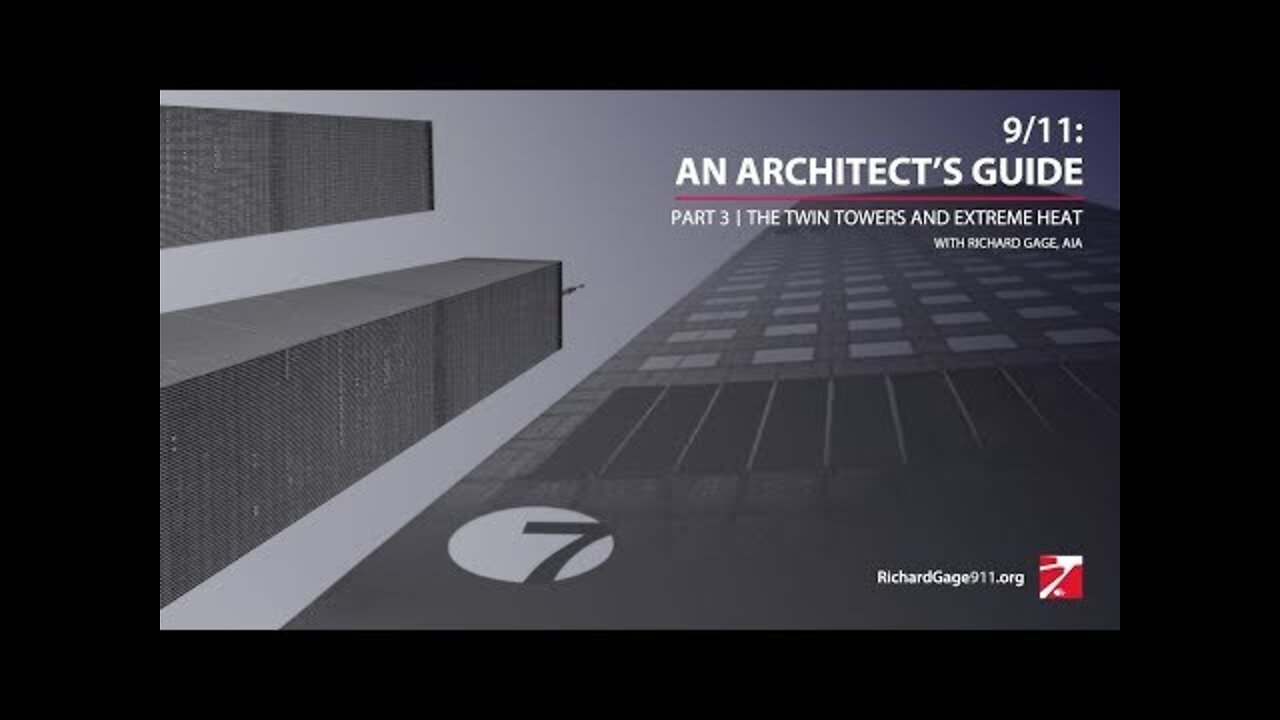Premium Only Content

9/11: An Architect's Guide - Part 3: The Twin Towers and Extreme Heat (10/19/21 Webinar - R Gage)
9/11: An Architect’s Guide | Part 3: The Twin Towers and Extreme Heat
Course Number: RG911-AAG-L3
Live three-part webinar series. Each part is about 1 1/2 hours long.
We are dedicated to conducting research and providing education about the complete destruction of the three World Trade Center skyscrapers, our courses give architects the technical knowledge and analytical framework with which to evaluate the most likely cause of those building failures.
Course Description:
Never before has a steel-framed high-rise collapsed from fire. Why, then, did three such buildings collapse on September 11, 2001?
In Part 3 of “9/11: An Architect’s Guide,” Richard Gage, AIA, provides an overview of the most important evidence related to the extreme heat observed both before and after the Twin Towers’ destruction.
As documented extensively in the report issued by the National Institute of Standards and Technology (NIST), molten metal was seen pouring out of the South Tower during the seven minutes leading up to its collapse. Molten metal was also observed in the debris of both buildings, while various other evidence of extreme heat and incendiary chemical reactions have been documented since.
In 2005, NIST concluded that the Twin Towers’ destruction resulted from the combined effects of the airplane impact damage and ensuing fires, both of which are phenomena that fail to account for the extreme heat observed before and after the Twin Towers’ destruction.
Does NIST’s explanation for these unprecedented structural failures explain all of the evidence? Together, we will study the collapses and evaluate which of the two leading hypotheses — fire-induced failure or controlled demolition — is more consistent with the evidence. Participants will be encouraged to decide for themselves if a new investigation is warranted.
Learning Objectives:
Participants will be able to:
1. Describe the characteristics of building fires and the aspects of high-rise design that contribute to make fire-induced failure in steel-framed high-rise buildings a rare occurrence.
2. Recognize the distinct features associated with fire-induced failure and the distinct features associated with the procedure of controlled demolition.
3. Describe step-by-step the series of structural failures that the National Institute of Standards and Technology found to be the most likely cause of the collapse of World Trade Center Twin Towers.
4. Analyze the physical evidence and the dynamics of the collapse of the Twin Towers according to how consistent it is with the competing hypotheses of fire-induced failure and controlled demolition.
Visit http://RichardGage911.org for more information.
#richardgage911 #richardgage911:unleashed! #wtc7 #911con #worldtradecenter #richardgage #911anarchitectsguide #webinar911
Content Managed by ContentSafe.co
-
 1:00:40
1:00:40
RichardGage911
1 month agoBuilding 7 - All You Need to Know in 1-hour | Richard Gage Presents to BNN
4661 -
 8:09:50
8:09:50
Dr Disrespect
18 hours ago🔴LIVE - DR DISRESPECT - MARVEL RIVALS - GOLD VANGUARD
203K33 -
 1:15:00
1:15:00
Awaken With JP
17 hours agoMerry Christmas NOT Happy Holidays! Special - LIES Ep 71
236K191 -
 1:42:21
1:42:21
The Quartering
18 hours agoTrump To INVADE Mexico, Take Back Panama Canal Too! NYC Human Torch & Matt Gaetz Report Drops!
177K110 -
 2:23:15
2:23:15
Nerdrotic
18 hours ago $14.60 earnedA Very Merry Christmas | FNT Square Up - Nerdrotic Nooner 453
133K13 -
 1:14:05
1:14:05
Tucker Carlson
18 hours ago“I’ll Win With or Without You,” Teamsters Union President Reveals Kamala Harris’s Famous Last Words
233K382 -
 1:58:31
1:58:31
The Dilley Show
18 hours ago $36.92 earnedTrump Conquering Western Hemisphere? w/Author Brenden Dilley 12/23/2024
172K50 -
 1:09:59
1:09:59
Geeks + Gamers
19 hours agoSonic 3 DESTROYS Mufasa And Disney, Naughty Dog Actress SLAMS Gamers Over Intergalactic
117K21 -
 51:59
51:59
The Dan Bongino Show
20 hours agoDemocrat Donor Admits The Scary Truth (Ep. 2393) - 12/23/2024
943K3.15K -
 2:32:15
2:32:15
Matt Kohrs
1 day agoRumble CEO Chris Pavlovski Talks $775M Tether Partnership || The MK Show
146K36